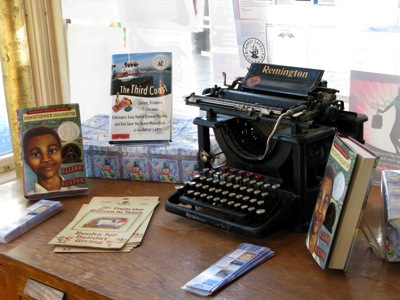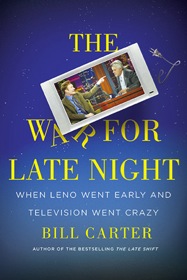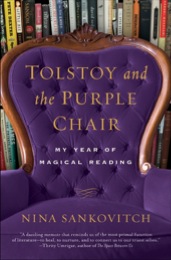Recommended Reading For Winter 2011 - 12


The War for Late Night: When Leno Went Early and Television Went Crazy [Paperback]
The War for Late Night: When Leno Went Early and Television Went Crazy [Kindle Edition]
By Bill Carter
2010 – Viking, 416 pages
Like many baby boomers, I grew up watching The Tonight Show with Johnny Carson. It was sometimes entertaining, sometimes not, but with only a handful of channels to choose from, it basically won by default -- especially since my parents refused to watch anything else. In the 1970s I moved on to Dick Cavett, and by the 1980s, I was watching Late Night with David Letterman, which followed The Tonight Show. So when Carson retired in 1992, I probably hadn’t seen more than a dozen Tonight shows in fifteen years, but along with everyone else, I was engrossed by the public struggle to be Johnny’s successor that quickly ensued. The only real contenders were David Letterman and Jay Leno. Unfortunately the funnier man – and Carson’s personal choice – did not win.
Instead the network anointed Jay Leno as the new Tonight Show host, prompting Letterman to move to CBS where he launched The Late Show with David Letterman at 11:30. All this was chronicled in Bill Carter’s 1995 book The Late Shift: Letterman, Leno, and the Network Battle for the Night. Who could have suspected that this tumultuous struggle for the Tonight Show would be repeated over 15 years later. Well, perhaps Bill Carter wasn’t surprised since his latest book on the fight for late night proves that he’s the ‘go to guy’ when it comes to deconstructing the power plays for the job of Tonight Show host.
Because the events are so recent – Conan O’Brien left the Tonight Show in January 2010 – some of The War for Late Night will seem familiar ground to TV lovers. However Carter is ruthlessly meticulous about getting all the facts down, and even the biggest late night fan will find much that is new as he describes the behind the scenes struggle at the network. And each of the late night hosts – Leno, Letterman, Conan, Kimmel, Stewart, Fallon, Colbert, Ferguson – are given their turn in the spotlight as Carter tells the story of their early years and how they eventually found themselves behind the desk of a talk show. Some details were unexpected. For example, who knew that iconoclastic Stephen Colbert is a happily married father of three who lives in the suburbs and teaches Sunday School at his church.
Although the book focuses on the struggle between Conan and Leno for The Tonight Show job, the book deals extensively with Letterman. Idolized not only by Conan, but by most late night talk show hosts, Letterman remains an enigmatic figure even to his closest co-workers. Even an NBC executive gives Letterman his props. Speaking about Letterman’s masterful handling of the aftermath of 9/11 on The Late Show, he admits “Everybody looked to Dave for the way to do this. If there’s a Johnny out there, it’s Dave.”
Still, The War for Late Night is about Leno and Conan and the puzzling fixation these men (and Letterman) have for The Tonight Show. To me, it’s just one of many late night talk shows, all of which I basically ignore in order to watch syndicated reruns of Seinfeld, The Office and 30 Rock. And given the falling ratings numbers, it appears that most of the country is following suit. With cable, DVRs, and the graying of the viewing public that watches The Tonight Show, it may baffle readers to learn just how much money and emotion is invested in that 60-minute time slot.
The War for Late Night will tell you exactly how much money ($32 million a year for Leno) and how much emotion. When Conan ultimately stepped down from The Tonight Show, it was because he refused to move the start time back to midnight in order to accommodate a proposed 30-minute Leno show at 11:30. Conan “would not be accomplice to the destruction that this idea of NBC’s might inflict on the greatest franchise in television history…if NBC would truly force him to decide whether to give up his dream or play a role in undermining a cultural landmark, then maybe it would be better for him to try find someplace else to work.”
Whether you’re a Conan fan or a Leno fan, don’t expect the book to change your mind either way. Both men come off as decent, hard-working and genuinely likable. However they do have distinctly different views as to what The Tonight Show represents and therein lies all the difference.
My only criticism of the book is that it seems about 100 pages too long. At times, the story is given as much weight as the battle for an actual crown, TV’s version of the War of the Roses. In fact, the whole struggle for late night as described by Carter seems remarkably similar to a treacherous Renaissance court: Zucker playing the role of manipulative minister, the affiliates embodying contentious courtiers, Conan as the ‘Once and Future King’ and Leno as the monarch who refuses to step down. But if you love TV – and let’s not lie, most of us do – then The War for Late Night will provide as much entertainment as a week’s worth of late show viewings.
As for me, I’m old enough to remember Steve Allen and his late night show. For my money, he was funnier than all of them.
(Sharon Pisacreta, Dec. 2011)
Tolstoy and the Purple Chair: My Year of Magical Reading [Hardcover]
Tolstoy and the Purple Chair: My Year of Magical Reading [Kindle Edition]
By Nina Sankovitch
2011 – Harper, 256 pages
Those of us who are book lovers are accustomed to turning to the printed page for the three ‘E’s: entertainment, enlightenment and escape. But in Tolstoy and the Purple Chair, author Nina Sankovitch uses books as a way to find solace and healing after her sister’s death. The use of the word ‘magical’ in the title tips off the reader that this is indeed what occurred.
After her older sister dies of cancer at the age of 46, Sankovitch sets out to live life to the fullest. Her next three years are crammed with nonstop activity, yet grief continues to haunt her. She suspects what she needs to do is slow down and take the time to reflect and think. A lifelong reader, she decides to undertake a literary journey in which she commits to reading a book every day for a year. This idea seems especially fitting since she and her sister shared a deep love of books. She writes, “That was how I wanted to use books; as an escape back to life. I wanted to engulf myself in books and come up whole again.”
Beginning the reading project on her own 46th birthday, Sankovitch vows to read a book each day and follow it with a review which she plans to post on her blog. She had already put up a website dedicated to reading, and her new project seemed a natural extension of that, as well as a perfect place to track her progress. Choosing a downstairs room as her main reading spot, she fills it with books she intends to read along with a large comfortable chair upholstered in purple fabric. On her first official day of reading for the project, she chooses Muriel Barbery’s The Elegance of the Hedgehog and is heartened when she manages to finish it by midnight. She decides that this seems doable and looks forward to the remaining 364 books.
As a mother of four school-age boys, Sankovitch has to find a way to work around the busy schedules of her sons and her husband, while also making time for the obligatory cooking, cleaning, grocery shopping etc. Because of that, she limits her reading list to books that are no thicker than an inch; this translates into a length of 250-300 pages. Anything longer would be too difficult to read in one day, especially when factoring in the review. In fact, she soon learns that writing a book review often required two hours of writing time.
Sankovitch does set up ground rules. There would be no rereading of books she had already read, nor could she read any author more than once. And she soon found herself choosing her books – both fiction and nonfiction - simply because of an interesting title. And she refused to waste her time on a book that didn’t hold her interest. If it failed to engage her in the first 10 pages, she put it down and reached for another book waiting on her shelf.
Life often intervened. There were days when it was less than three hours to midnight and she still had a couple hundred pages to read. Yet Sankovitch faithfully keeps to her schedule and one year later she is gratified and pleased to realize that she has not missed a single day of reading.
Because her family – devoted readers all -- are nearly as caught up in her project as she is, they sometimes recommend books. Her son George asked her to read Watership Down, a favorite book of his, and although it was nearly 500 pages long, Sankovitch couldn’t refuse.
As the months go by, many of the books reward her with much needed insights and epiphanies. Julian Barnes’ Nothing To Be Frightened Of teaches her not to give up on life despite its difficulties and hardships. Let the Great World Spin by Colum McCanns reminds her that small moments of promise can reignite a belief that the world is a kind and forgiving place. Almudena Solana’s The Curriculum Vitae of Aurora Ortiz celebrates the importance of making time in life for reflection and thought. And The Little Bee by Chris Cleave shows her the truth of how connected we are with beauty and with the rest of the world.
Don’t assume that all of the books she read were lofty literary works. Her reading list included Stephanie Meyer’s Twilight, Nancy Atherton’s Aunt Dimity Slays the Dragon, and such perennial genre favorites as Agatha Christie, Dennis Lehane, and P.D. James. Indeed, mysteries assured her that there is an order to the universe, while whodunits sometimes cautioned that not all questions may have an answer.
The ‘Tolstoy’ mentioned in the title refers to Leo Tolstoy’s novella The Forged Coupon which explores the importance of unexpected events in one’s life. Although Sankovitch read the novella early on in her reading project, she confesses that she didn’t really understand its message until the year was nearly over. What Tolstoy taught her was that the meaning of life does not hinge on the joyous or tragic events we experience, but rather on how we respond to these events, and on how much assistance we extend to others.
At the end of the book, Sankovitch lists all the books she read between October 28, 2008 and October 28, 2009. As mentioned earlier, it is an eclectic list that includes The Fall by Albert Camus, Bird by Bird by Annie Lamott, Rudyard Kipling’s Captains Courageous and The Detective Wore Silk Drawers by Peter Lovesey. I was also surprised to discover how many of these books I hadn’t gotten around to reading yet.
A heartfelt and eloquent memoir, Tolstoy and the Purple Chair examines not only the pain of loss and grief, but also the ability of books to help restore us to a meaningful life. As Sankovitch writes towards the end, “During my yearlong respite filled with books, I recuperated. Even more, I learned how to move beyond recuperation to living...I immersed myself in the world the authors had created, and I witnessed new ways of handling the twists and turns of life, discovering tools of humor and empathy and connection. Through my reading, I reached the point of understanding so much.”
Quite a payback for a year spent in an overstuffed purple chair reading library books. And if you’re looking for an excellent way to while away just one day reading, I recommend sitting back with a copy of Nina Sankovitch’s Tolstoy and the Purple Chair.
(Sharon Pisacreta, Dec. 2011)
December '11 - January '12